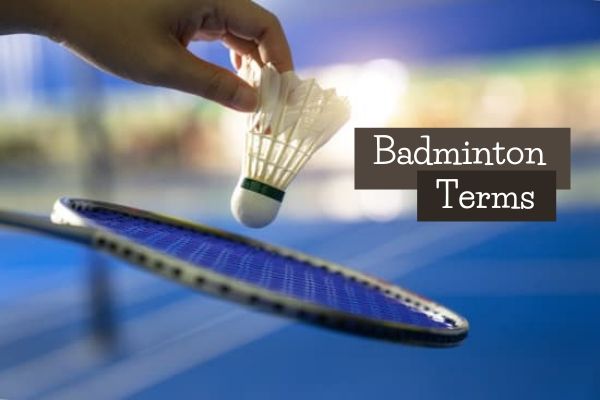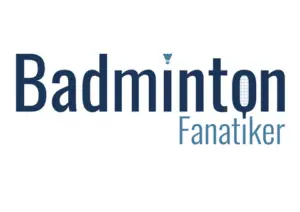The world of Badminton can be a strange place with some rather odd vocabulary and terminology. If you’re new and inexperienced, then it might be a daunting task to learn the strange terms and vocabulary, let alone trying to actually play the game against someone.
Not to worry, you have come to the right place. I’m going to be going through the most commonly used badminton terms and their meanings in a simple and easy way to understand.
Hopefully, this means you’ll have more time to practice and play instead of being confused as to what your opponent is going on about. All the key phrases and terminology is listed in alphabetical order for your ease of use. Let’s get started!

A
All – Refers to a level score in the game. For example, 7-7 would be scored as Seven all.
Ally – Additional area for doubles matches. The area is extended by 1.5 feet.
Ace – Winning the point without the opponent touching your service. Very similar to tennis but a lot harder to do in badminton.
Air Shot – Missing the shuttlecock completely. Don’t do this!
B
Back Ally – Back boundary line to the long service line. Used for doubles play exclusively.
Backhand – A type of stroke. If you are right-handed, this will be a stroke played on the left side and vice versa if you are left-handed.
Badminton Strokes – Swinging your racquet, commonly referred to as your motion. They are not shots.
Baseline – Marks the outer play area at the breadth of the court.
Baseline Smash – A smash shot from your baseline.
Brush – Used to win points at the net quickly with a different technique. This is a relatively uncommon shot to play as most play a “kill shot”.
C
Carry – The shuttlecock gets stuck in the strings and doesn’t deflect off them. This is a violation.
Centre Line – The line that divides the right and left courts.
Clear Lob – A defensive shot that is hit as far back as possible onto the opponent’s baseline.
Court – The area where the shuttlecock must land. It’s 13.4 meters long and 6.1 meters wide for doubles. For singles, it’s 13.4 meters long and 5.18 meters wide.
D
Deuce – This means the score is 20-20. One player must win by two clear points at this point.
Drive – Fast shot that is played close to the net. It remains horizontal until the mid-court, where it should drop downwards.
Drop Shot – Dropping the shuttle close to the net of your opponent before they can get to it.
F
Fault – A major violation of the rules where you will lose a point. For example, hitting the shuttlecock into the net.
Feint – A pretend shot to try and deceive your opponent.
Flick – Changing your shot from a slow one to a fast shot by flicking your wrist faster.
Follow-Through – Finishing your stroke.
Forecourt – The front area of the court. Also known as the first third.
Forehand – Playing a right-sided shot if you are right-handed and vice versa if you are left-handed.
Full Smash – Hitting the shuttlecock as hard as you can.
G
Game – Getting 21 points before your opponent. This makes part of a set.
H
Hairpin net shot – Your shot starts low, just goes over the net and lands close to your opponent’s net.
Half-court shot – A shot that stays low in the mid-court, mostly used in doubles.
Half Smash – Hitting a smash without hitting the shuttlecock as hard as you can. This is more of a tactical shot to try and move your opponent into an uncomfortable area on the court.
Handle – Part of the racquet that you hold.
High clear – A shot that pushes the attacking player back into their baseline. Mostly a defensive shot.
L
Let – A minor violation of the rules or an accidental occurrence where the rally stops and is played again without changing the positions or scores. For example, the opponent isn’t ready for your serve.
Line Judge – A person who decides if the shuttlecock lands in or out of the court.
Long Service Line – The serve can’t go past this point. For singles, it’s the boundary line at the breadth of the court. For doubles, it’s 2.5 feet inside the singles line.
Love – Where one of the players has not won a point yet. For example, 4-0 would be Four – Love.
Lunge – A shot where you stretch to get the shuttlecock. Mostly happens in the frontcourt.
M
Match – A match has 3 sets (games). You have to win two of them to win. If the score is 1-1, then you play a 3rd set, known as the rubber game.
Match Umpire – The person who enforces the rules and keeps the match running smoothly.
Mid-court – The middle third of the court.
N
Net Kill – A fast shot played from the net that can’t be returned. This is played downwards into the court so that the opponent has little chance of returning it.
Net Lift – A shot played from the net that travels high above your opponent towards the baseline.
Net shot – A shot hit from the net that drops quickly on your side.
P
Passing shot – A shot where you pass the shuttlecock to either your teammate or the opposing team.
Push – A gentle shot that moves the shuttlecock forwards smoothly.
R
Racket (or Racquet) – The specialist equipment you use to play badminton with.
Racket Head – The top part of the racquet where the strings are located that is metal.
Racket Shaft – The connection from the handle to the racket head.
Rally – An exchange of shots from yourself to the opponent.
Rear court – The last third of the court.
Receiver – The person who is is receiving the serve.
Rubber – The third and final deciding game of a badminton match if the score in sets is 1-1.
S
Set – The first person to win 21 points by two clear points wins the set. In badminton, a match is played for 3 sets of 21 points each.
Server – Person who is serving the shuttlecock.
Service court – The area where your shuttlecock must land. The area will be depending on if you’re playing singles or doubles.
Service Judge – The person who judges for faults in the match overall.
Service Over – When a rally is lost, the serve will change over to either yourself or your opponent depending on who served and who lost the rally.
Short Serve – This is a serve that lands short on the opponent’s side of the court, just behind the short service line.
Short service line – This is the line that is 1.98 meters away from the net.
Shuttlecock – The object that is hit back and forth between the two players.
Singles Footwork Base – Also called “base position”, this is where you return to when you have played a stroke. This is normally in the middle of the singles court. This is a singles term.
Singles side-line – This is the area used in singles that measures the width of the singles court.
Smash – This is a stroke that is hit from baseline to baseline mostly. A perfect smash will go over your side of the net and drop quickly on the other side of the net. This is the primary offensive shot that is played overhead.
String Bed – This is where your strings lay on the racquet.
T
Throat/T-Joint – This is where the shaft of your racquet and racquet head are connected.
Tournament Referee – The main decision-maker of the rules. If the umpire cannot resolve an issue with the players, the tournament referee will do so. They are not an umpire, however.
Tumbling/Spinning Net Shot – A normal net shot where the shuttlecock is spinning towards the ground.
W
Wide – When a shot goes out of the court width ways rather than long. The “wide” area depends on if you are playing singles or doubles.
Wood shot – A shot played when you miss the shuttlecock, and it hits the frame of the racquet, not the strings.
So as you can see, an awful lot to learn there. However, some of the words and phrases aren’t really that common, especially in a match, but its always handy to know what they mean.
Try to learn the most basic, relevant, and simple rules, phrases, and terminology first before you start playing. Remember, there should always be an umpire and a tournament referee to help you if you or your opponent don’t understand something or disagree.
However, I think the best way to learn all of these phrases and terminology in the shortest amount of time possible is to actually play badminton even if it is with family or friends! I would certainly encourage you to give it a go.
Badminton is a great game that focuses so much on fitness, reflexes, hand-eye coordination, speed, and flexibility. By having a basic understanding of the simplest phrases, vocabulary, and terminology, you will have access to a sport that you can enjoy both recreationally or competitively.
Your knowledge of everything badminton will improve the more you play!
I hope this article was helpful. Do share it if you think it would be useful for others as well.
Now that you’ve learned a lot about badminton, it’s time to challenge yourself and take the badminton quiz we have created. Click here to check it out and test your knowledge.
Thanks for reading!
